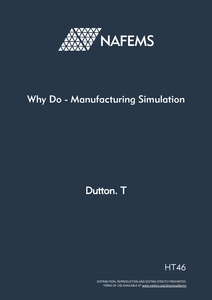
In keeping with the Why Do - … series prepared by NAFEMS, this book aims to demonstrate why it is beneficial to carry out computer-based simulation, in this case specifically of the manufacturing process that transforms raw material into a formed product as part of the product development cycle. The book is aimed at engineers and managers who may be unfamiliar with the scope of manufacturing simulation methods but wish to understand the benefits to their products and processes. These benefits may be in the form of increased knowledge of the process enabling more successful outcomes, optimisation of the process to ensure that the best quality product is produced at the lowest price, and an improved understanding of the characteristics of the formed component.
The book explains what is meant by manufacturing simulation and how it relates to Computer Aided Engineering (CAE) methods in the wider sense. It will show how simulation can be applied to a variety of processes across a range of raw materials – although it is by no means a comprehensive description of all such methods.
An introduction sets out the scope followed by a description of manufacturing simulation and its relationship to CAE more generally, highlighting both the particular challenges and the potential benefits, before a discussion on applying simulation. A sequence of chapters then illustrates the role of manufacturing simulation for a range of processes, grouped by materials – Sheet Metals, Bulk Metals, Plastics and Composites, with a further chapter noting other materials and processes of interest including the emerging field of Additive Manufacturing. Industrial case studies are used to illustrate many of these applications. Simulation of joining and assembly processes is discussed in outline only, identifying the interaction between forming and joining. The application of optimisation techniques is then presented, before a closing discussion of the current status and possible future developments.
This book is a high level review of the topic to demonstrate how manufacturing simulation can be applied and the benefits it can bring. No attempt is made to explain the underlying physical models and mathematical solution methods involved in simulation but a number of references and additional resource material is provided at the end of the book for those who wish to investigate further. In due course, it may be appropriate to explore the numerical methods in more detail in a future volume in NAFEMS “How to…” series.
Contents
- Introduction
- Overview of Manufacturing Simulation
- Applying Simulation
- Sheet Metal Forming
- Bulk Metal Forming
- Forming Plastics
- Forming Composites
- Other Materials and Processes
- Overview of Joining Process Simulation
- Optimisation and Robustness
- Current Status and Future Developments
- Concluding Remarks
- Appendix 1: Vendors for Simulation Software
- Appendix 2: Conferences and other Fora



